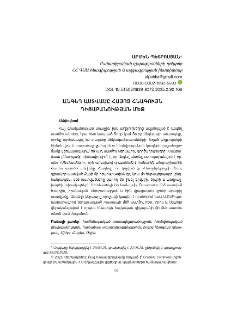Object
Title: Անգեղ Աստվածը հայոց հնագույն դիցաբանության մեջ
Publication Details:
«Բանբեր հայագիտության» միջազգային գիտական հանդեսը լույս է տեսնում 2013 թվականից։
Journal or Publication Title:
Բանբեր հայագիտության = Вестник Арменоведения = Review of Armenian studies
Date of publication:
Number:
ISSN:
Official URL:
Additional Information:
Other title:
The God Angeł In Earliest Armenian Mythology
Contributor(s):
Գլխավոր խմբագիր՝ Պ. Ա. Չոբանյան (2013-2017) ; Ա. Խառատյան (2017-)
Coverage:
Abstract:
Հայ գրականության առաջին իսկ աղբյուրներից ավանդված է Անգեղ աստծու անունը, նրա հետ կապված Տորք կամ Տուրք Անգեղյայի առասպելը, որոնք արժանացել են տարբեր մեկնաբանությունների: Եղած աղբյուրների հիման վրա և տարածաշրջանային ու հնդեվրոպական կապերի բացահայտմամբ վերականգնվում են այդ աստծու կերպարը, գործառույթները: Մանրամասն քննությամբ հիմնավորվում է, որ Անգեղ անունը ստուգաբանվում է որպես «Անտեսանելի», որն այդպիսով զուգահեռն է հունարեն անդրաշխարհի Հադես աստծու անվանը: Հադեսը, որ կոչվում էր «Ստորերկրայքի Զևս», գլխավոր աստված Զևսի մի հիպոստասիսն էր, նրա մի ենթակերպարը (ընդհանրապես, մեծ աստվածները կարող են լինել երկնքի, երկրի և անդրաշխարհի տիրակալներ): Անտեսանելի են համարվել Ուրարտուի մեծ աստված Խալդին, իրանական Ահուրամազդան և հին վրացական կրոնի արարիչ աստվածը: Անգեղի կերպարը որոշակի կապեր է դրսևորում նաև U.GUR գաղափարագրով ներկայացված Հայասայի մեծ աստծու հետ, որով և Անգեղը վերականգնվում է որպես հնագույն հայկական դիցարանի մի մեծ աստծու անուն կամ մականուն:
In the ancient Armenian translation of the Bible, the Mesopotamian god of the afterlife and war Nergal is represented as Angeł. The same name is known in two legends from the books of Khorenatsi and Sebeos. It is interpreted as ‘unsightly, not nice, ugly,’ which seems rather inappropriate for a theonym. However, in the Assyrian myth, Nergal is invisible to the vizier of the goddess of the underworld. Hence the opportunity to etymologize Angeł not as an-geł ‘having no look,’ i.e. ‘invisible’ but to refer to the Indo-European context, where the closest cognate of the Armenian language is Greek. Thus, Angeł would correspond well with the Greek name of the underworld and its god Hades: Ἀΐδης, literally, ‘the Unseen’ < *ṇ-wid-. Supreme gods could be the lords of the “three worlds” – heaven, earth, and the underworld, and the Greek Hades, known as “Zeus of the underworld,” was thus one of the incarnations of Zeus. In ancient Armenian tradition, these functions would be attributed to Angeł. Notably, the supreme gods of some other ancient states of the region were also conceived to be invisible. However, the name and image of the epic hero Turk' Angełeay, i.e. “The gift of (god) Angeł,” should most probably be interpreted as the son of the god Angeł.
Place of publishing:
Երևան
Publisher:
Format:
Identifier:
click here to follow the link ; oai:arar.sci.am:415578
Call number:
Location of original object:
ՀՀ ԳԱԱ Հիմնարար գիտական գրադարան
Object collections:
Last modified:
Oct 6, 2025
In our library since:
Oct 6, 2025
Number of object content hits:
36
All available object's versions:
https://arar.sci.am/publication/449995
Show description in RDF format:
Show description in OAI-PMH format:
-
Բանբեր հայագիտության = Вестник Арменоведения = Review of Armenian studies
-
Բանբեր հայագիտության, 2013
-
Բանբեր հայագիտության, 2014
-
Բանբեր հայագիտության, 2015
-
Բանբեր հայագիտության, 2016
-
Բանբեր հայագիտության, 2017
-
Բանբեր հայագիտության, 2018
-
Բանբեր հայագիտության, 2019
-
Բանբեր հայագիտության, 2020
-
Բանբեր հայագիտության, 2021
-
Բանբեր հայագիտության, 2022
-
Բանբեր հայագիտության, 2023
-
Բանբեր հայագիտության, 2024
-
Բանբեր հայագիտության, 2025
-
Բանբեր հայագիտության, 2025, 1
-
Բանբեր հայագիտության, 2025, 2
- Կազմ; Խմբագրական խորհուրդ; Գիտական խորհուրդ
- Contents
- The Past and Present Languages of the People of Azerbaijan
- The Struggle between Urartu and Assyria during the Reign of Rusa, Son of Sarduri: According to the Research of C. F. Lehmann-Haupt
- Hunchak Figure Tashir (Simon Hovvian): Public and Political Activities, 1915–1921
- The Coverage of Educational and Cultural Issues of the First Republic of Armenia in the Pages of the “Chakatamart” Daily Newspaper (1918–1920)
- The Armenian Genocide in Art, Film, and International Relations
- The Reinterpretation of the History of the Defence Army of the Republic of Artsakh in Armenian Historiography
- Անգեղ Աստվածը հայոց հնագույն դիցաբանության մեջ
- Հայ պատմիչները միջնադարյան Հայաստանում գործածված զենքերի ու սպառազինության մասին
- Manifestations of Genocide Psychotrauma in Andranik Tsarukyan’s Novella “People Without Childhood”
- Karine Khodikyan's Biographical and Creative Profile and the “Two Plays” Collection
- Անառակ որդու վերադարձը կամ՝ Եղիշե Չարենցը Աստծու հայացքի ներքո
- Davit Evereklyan: His Activities In Montreal
- A Collection Dedicated to the Works of Perch Terzian
- A View from the Outside: The Collection “The Continuing Paths of Life” as the Living Voice of the Diaspora
- Arshak Safrastian’s report read at the XXI Congress of Orientalists held in Paris
-
Բանբեր հայագիտության, 2025, 1
-
Բանբեր հայագիտության, 2013
| Edition name | Date |
|---|---|
| Պետրոսյան, Արմեն, Անգեղ Աստվածը հայոց հնագույն դիցաբանության մեջ | Oct 6, 2025 |





